Overview
Advantages of Laminated Glass
PVB Laminated Glass Is One Of The Most Important Glazings Where Impact Strength is major concern
Outstanding Impact Strength
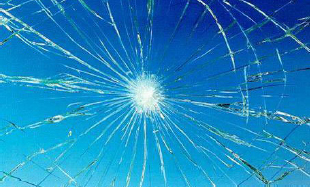
General window glass is brittle. It breaks into sharp pieces which could cause serious and sometimes fatal injuries.
Ultra high elasticity of interlayer film is always selected when safety comes first. For example, PVB is widely used in laminated glass manufacturing. It has super high tensile strength due to its ultra high elasticity. The strong tensile strength allows the laminated glass resist to high impact. The high impact strength prevents from penetration. The interlayer absorbs the energy of the impact and thus, resisting penetration. Laminated glass plays very important role in safety glass industries.
Burglars often break windows to get to door and window handles. Laminated glass can resist their invasion. If it is accidentally broken, the interlayer continues to safeguard the building. Replacement can be done when convenient and during less expensive hours.
The rise in urban crime has created a need for glazing materials that enable people to carry on normally and be protected from harm.
Prevents Injuries from Flying Glass
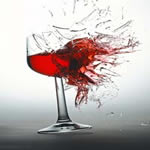
Proper selected interlayer film has good adhesion ability with glass. When laminated glass is broken, glass fragments remain firmly bonded to the interlayer. They do not fall off. The plastic film holds the broken glass chips in place when glass breaks, helping to lessen injuries from flying glass. This feature is remarkable when glass is installed in atrium, roof, glass skylights, sunspaces or sloped glazing, etc. If it is not laminated glass, flying or falling glass could result in injuries. This is why many worldwide building codes require laminated glass for overhead glazing.
Stop People from Falling Out
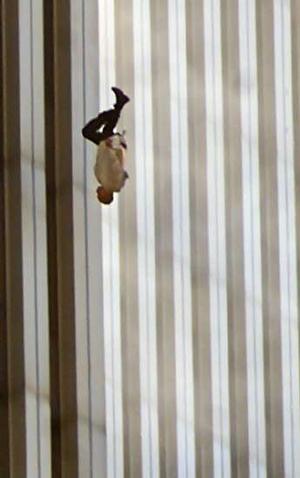
If laminated glass is installed within a frame, the broken glass does not fall out of the frame. This advantage is absolutely necessary especially when people could get in direct physical contact with the laminated glass. It prevents people from falling out of the building if the curtain wall is made of laminated glass. Meanwhile, it prevents people beneath the glass get hit.
Protection From Abnormal Weather
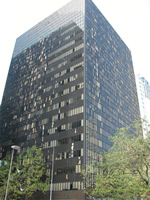
When laminated glass is broken, it remains in its frame preventing further damage, while reduced flying glass protects people and properties both indoors and outdoors.
In developed areas subject to heavy winds and rains such as hurricanes or cyclones, buildings often need extra protection. Flying debris carried by these winds can shatter the glass of windows and doors, injuring people and opening buildings to often devastating further damage. Laminated glass constructions can be properly designed to remain intact under impact and keep the envelope of the home or building sealed.
Glass fallout in earthquakes exposes people to dangerous broken shards. Again, laminated glass has been shown to keep the glass intact and in its frame.
UV Control

The major cause of deterioration and fading of furnishings and pictures is the chemical reaction caused by short-wavelength UV radiation. Proper selected interlayer film always consists of UV-absorbing additives which screen out almost all these damaging ultraviolet radiation from getting through. This avoids color fading and deterioration of internal decoration and furniture. People behind EVA laminated glass would be protected against skin cancer and aging.
Noise Reduction
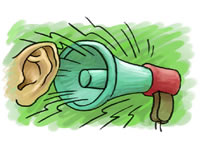
Noise, just like a burglar, gains easiest entry to homes and buildings through windows. Laminated glass is an excellent barrier to noise. It has a higher sound reduction index than monolithic glass of equal thickness between the frequencies of 125Hz and 4000Hz. It keeps away external noise especially high frequency sound. Transmission of sound is stop to maintain quiet environment behind glass. This sound dampening is due to the "viscoelastic" properties of the interlayer material. The coincidence effect experienced with monolithic glass at certain frequencies can also be considerably reduced with laminated glass.
Many building applications require a glass exterior but at the same time need to minimize sound transmission, such as a restaurant on a busy street. For this reason, laminated glasses with good acoustic dampening properties are used.
The noise reduction performance of IG units can be further improved by incorporating laminated glass. When noise reduction is one of the major concerns, special sound reduction interlayer particularly designed for sound barrier shall be selected.
Solar Energy Control
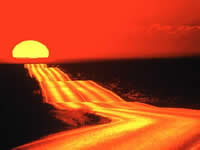
Natural light plays an important role in architectural design. While visible light transmits through general window, it also allows infra red to pass. So, too much sunlight can also mean too much heat. When laminated glass is made out of monolithic glass with proper characteristics, it reduces heat gain from sunlight to provide comfort environment and meanwhile, lower air conditioning or heating costs. Furthermore, it can also control glare.
The selected monolithic glass could be reflective coated glass and/or low-E glass with heat absorbing glass tints. In warm climates, these combine the penetration resistance and sound reducing qualities of laminated glass with good shading and energy management.
In laminated glass composed of reflective coated glass, the metallic coating always faces toward the inside of the laminate, not exposed to environment. This design prevents metallic coating from harmful dirt or any kind of contact resulting in scratching.
Design Versatility

Laminated glazings could be composed of many different types of monolithic glass. They could be annealed, toughened, heat-strengthened, spandrel, wired, patterned, tinted, reflective and low-E glasses, etc. Instead of tinted glass, tinted plastic interlayer could be selected to colour laminated glass, in transparent or opaque.
Special design interlayers with decorative pattern made by digital printings are available for aesthetic visual effects. The designs could be words, patterns, images or any custom request. The design is kept towards the inner side of laminated glass. So it keeps away from stains, fingerprint, abrasion, scratch or harsh cleaning agents. It is a durable and almost maintenance free personal stylish art piece while it is also a conventional laminated glass with full safety features.
Low Visual Distortion
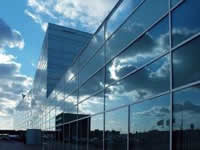
Laminated building glass is usually glazed in an annealed form, avoiding distortion caused by "roller waves" in tempered and heat-strengthened glass. Sharp reflected images are possible with curtain walls constructed of laminated annealed glass.
Easy Installation
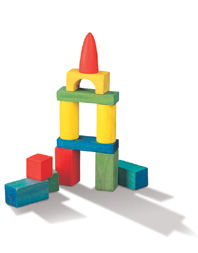
Laminated glass is simple to install. Cutting, drilling or notching can be done on site.
Durable

Laminated glass is durable. It maintains its characteristics, such as strength, UV control, sound insulation and solar control, etc for many years.
Maintenance Free
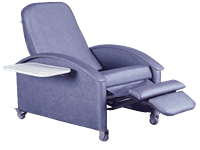
Cleaning is the only maintenance required. It is as easily cleaned as ordinary glass. No further maintenance is required until it is broken.